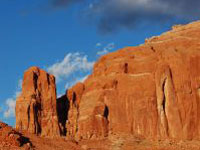Forget Alberta - U.S. Has Its Own Tar Sands Problem
 Globe-Net - Canada’s Athabasca tar sands are ground zero for much of the U.S. media commentary opposing the exploitation of ’dirty oil’. But a new flashpoint is emerging closer to home that may present a dilemma that one of President Obama’s dream team of advisors will have to sort out.
Globe-Net - Canada’s Athabasca tar sands are ground zero for much of the U.S. media commentary opposing the exploitation of ’dirty oil’. But a new flashpoint is emerging closer to home that may present a dilemma that one of President Obama’s dream team of advisors will have to sort out. Last month the Sierra Club and the Indigenous Environmental Network (IEN) joined forces to file a lawsuit against the U.S. Department of Interior and Bureau of Indians Affairs to challenge a proposed tar sands project by Petroglyph Energy on Antelope Creek in Duchesne County, eastern Utah.
“We are seeking to block a decision issued by the Bureau of Indian Affairs to expand a pilot project to include 720 acres of land near Bridgeland, Utah which would develop 300 wells on tribal and federal lands,” says Wayne Hoskisson, Utah Sierra Club.
“This project would suck rivers dry, poison water, pollute the air, and threaten fish and wildlife. At a time when the whole world is turning to clean energy, it doesn’t make sense to encourage such a wasteful and dangerous source of fuel,” said Hoskisson.
Petroglyph Energy, which has 18,000 acres under lease and which has drilled over 200 wells in the Antelope Creek field since the early 1990s, says the suit is irrelevant.
Paul Powell, Petroglyph’s executive vice president, says “Petroglyph has not been approved for any permits to expand drilling in the area. No action has been initiated, and none is planned to take place. So, the lawsuit doesn’t make sense.”
What is at issue is a 2004 Environmental Protection Agency (EPA) underground injection control permit issued to Petrogylph for oil and gas development in the area. At that time, the EPA stated that, “If the pilot project succeeds, the ultimate scope of the project could involve up to 8,008 steam injection wells spaced every 2.5 acres in a 32-square mile area.”
A filing by the Bureau of Indian Affairs (BIA) approved Petroglyph operating company’s thermally enhanced oil recovery development agreement with the Ute Indian Tribe. But, no permits were issued through the Bureau of Land Management (BLM) for federal lands development.
Roughly, 40 percent of the total acreage is administered under tribal authority with the remainder under BLM jurisdiction. As Powell states, “the proposed project was stopped when the permits were not approved.”
The Sierra Club - IEN lawsuit contents the environmental assessment accepted by the BIA is insufficient. Jihan Gearon, spokesperson for IEN, said “It is the BIA’s responsibility to protect the trust and assets of Tribes. By allowing this proposal to move forward on the basis of an outdated and inadequate environmental assessment, the BIA is failing in its fiduciary responsibility to insure the environment and well being of the local Ute tribe is protected.”
The Antelope Creek project presents an interesting challenge for the newly appointed U.S. Secretary of the Interior Ken Salazar. A former water and environmental lawyer and U.S. Senator, Salazar was a leader in the campaign for a renewable energy economy less dependent on foreign oil. The Bureau of Indian Affairs, which is responsible for the administration and management of millions of acres of land held in trust by the United States for American Indians, is part of his department.
Also part of his department is the Bureau of Land Management which manages 264 million acres of public land in 12 Western States and 300 million acres of below ground mineral assets throughout the country.
The Indigenous Environmental Network estimates that tar sands development the United States could increase U.S. greenhouse gas emissions from such projects from 27 to 126 million tons by 2015. In addition, the destruction of wildlife habitat and impacts on air and water quality would be severe.
The large quantities of water required for tar sands extraction would draw down surface water flows, adversely impacting stream habitat for fish and other species, and use upwards of 5.5 acre-feet of water each year for each well drilled.
“In our work on the Canadian tar sands development we’ve learned that this type of fossil fuel development is very harmful to human health and has contaminated water resources,” said IEN’s Gearon.
For More Information: Indigenous Environmental NetworkYou can return to the main Market News page, or press the Back button on your browser.

